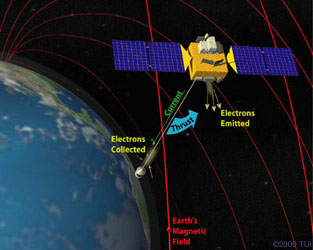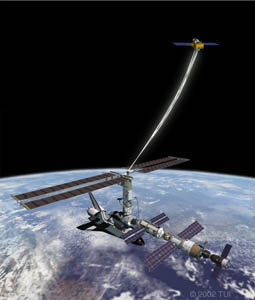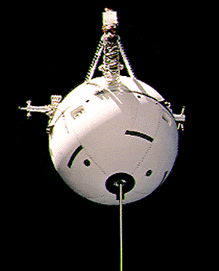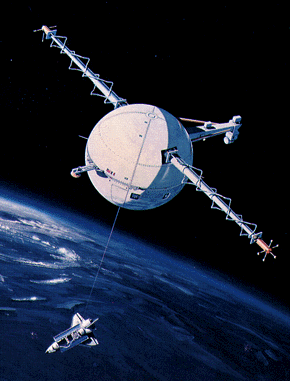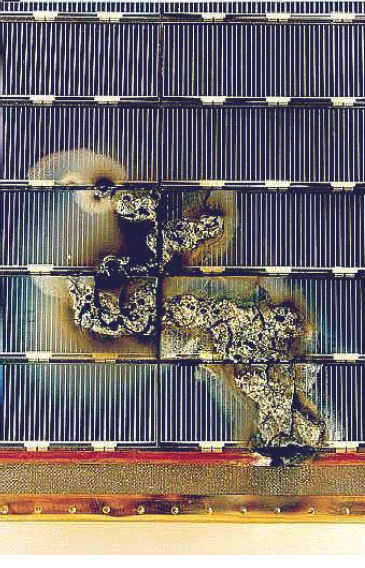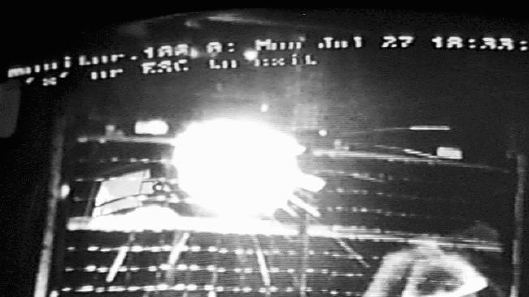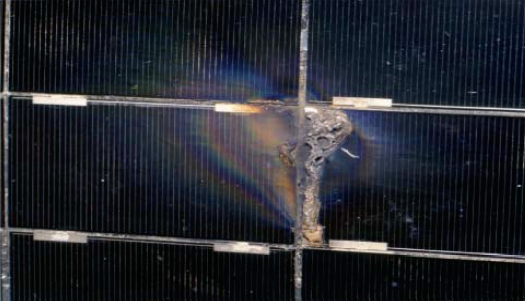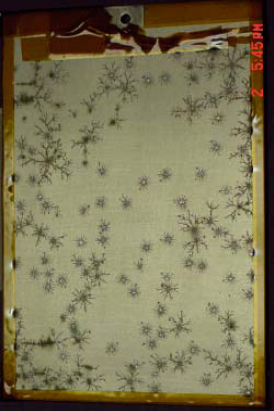|
Electrodynamic Tether |
||||
|
Electrodynamic Tethers An electrodynamic tether is essentially a long conducting wire extended from a spacecraft. The gravity gradient field (also known as the "tidal force") will tend to orient the tether in a vertical position. If the tether is orbiting around the Earth, it will be crossing the Earth's magnetic field lines at orbital velocity (7-8 km/s!). The motion of the conductor across the magnetic field induces a voltage along the length of the tether. This voltage can be up to several hundred volts per kilometer. In an "electrodynamic tether drag" system, such as
the Terminator Tether, the tether can be used to reduce the orbit of the
spacecraft to which it is attached. If the system has a means for collecting
electrons from the ionospheric plasma at one end of the tether and expelling
them back into the plasma at the other end of the tether, the voltage can
drive a current along the tether. This current will, in turn, interact
with the Earth's magnetic field to cause a Lorentz JXB force which will
oppose the motion of the tether and whatever it is attached to. This "electrodynamic
drag force" will decrease the orbit of the tether and its host spacecraft.
Essentially, the tether converts the orbital energy of the host spacecraft
into electrical power, which is dissipated as ohmic heating in the tether.
In a "electrodynamic propulsion" system, the tether can be used to boost the orbit of the spacecraft. If a power supply is added to the tether system and used to drive current in the direction opposite to that which it normally wants to flow, the tether can "push" against the Earth's magnetic field to raise the spacecraft's orbit. The major advantage of this technique compared to other space propulsion systems is that it doesn't require any propellant. It uses the Earth's magnetic field as its "reaction mass." By eliminating the need to launch large amounts of propellant into orbit, electrodynamic tethers can greatly reduce the cost of in space propulsion.
SOURCE Tethers Unlimited, Inc. For further information on an electrodynamic tether
system customized for your spacecraft application, please contact TUI at
info@tethers.com
|
||||
|
Columbia Tethered Satellite System-1R (TSS-1R) United States Microgravity Payload-3 (USMP-3) KSC Press Release No. 5-96 February 1996 The seven member international STS-75 crew will conduct scientific investigations with both the Tethered Satellite System-1R (TSS-1R) and United States Microgravity Payload-3 (USMP-3) primary payloads during the 75th Space Shuttle mission. The 13 day, 16- hour space flight will begin when the Space Shuttle Orbiter Columbia lifts off from Launch Pad 39B and climbs to a 184-statute-mile-high orbit with a 28.45- degree inclination to the Earth's equator. Once in orbit, the 5 foot (1.6 meter) in diameter TSS-1R satellite will be deployed from its pallet in Columbia's payload bay to a distance of 12.4 miles (20.7 kilometers) above the orbiter as an attached, electrically conductive tether the diameter of a wooden matchstick unwinds from a motorized reel. After the TSS-1R investigations and retrieval of the satellite, the crew will conduct research with four major USMP-3 experiment packages in Columbia's payload bay and three combustion experiments in a Glove box facility located in the orbiter’s mid deck area. The STS-75 mission is scheduled to end with Columbia's
touchdown at the KSC Shuttle Landing Facility.
The Crew The STS-75 crew includes two European Space Agency (ESA) astronauts and one from the Italian Space Agency (ASI), as well as four veterans of STS-46, the first TSS-1 mission. Mission Commander Andrew M. Allen (Major, USMC) is on his third space flight, having served as pilot of both STS-62 and STS-46. The Pilot is Scott J. "Doc" Horowitz (Ph.D.) (Major, USAF), who is on his first Shuttle mission. Payload Commander Franklin R. Chang-Diaz (Ph.D.) has flown on STS-60, STS-46, STS-34, and STS 61-C. Mission Specialist Jeffrey A. Hoffman (Ph.D.) has served in this capacity on STS 61, STS-46, STS-35 and STS 51-D. Mission Specialist Claude Nicollier (ESA) has flown on both STS-61 and STS-46. Mission Specialist Maurizio Cheli (ESA) is a lieutenant colonel in the Italian Air Force. Payload Specialist Umberto Guidoni (ASI) is the project scientist responsible for the integration of the Electrodynamic Tether Effects (RETE) experiment on the TSS-1R. The TSS-1R Mission The TSS program is a joint venture between ASI and NASA. Its objectives on this flight are to demonstrate the ability to deploy and control satellites on long tethers in space and to conduct space plasma experiments that include the generation of electrical power. The TSS-1 first flew on STS-46 in 1992, but a mechanical problem allowed the satellite to be deployed only to height of 840 feet. The "R" designation indicates a reflight of the same payload with modifications. The primary TSS-1R components are the 1,141- pound (518 kilogram) satellite, its deployer system mounted on a Spacelab pallet in the orbiter payload bay and the Spacelab Mission Peculiar Equipment Support Structure (MPESS) that holds the three- orbiter-based science instruments to be used in TSS-1R experiments. The satellite carries an additional four instruments. This sphere has an aluminum alloy skin that is electrically conductive, three instrument sensor booms, a payload module for the science instruments and a service module that contains telemetry, power distribution, data handling and navigational equipment. The middle section contains a gaseous nitrogen tank that will fuel the 12 low powered thrusters that will propel the satellite during deployment above the orbiter. Deployment, Experiments and Retrieval On Flight Day 3, the crew will begin deployment by raising a 40 foot (12 meter) deployment boom that elevates the satellite and its support structure to this height. Once released, the satellite will climb upward from the orbiter and away from Earth, aided by gravitational force and the use of its onboard thrusters, to attain a distance of 12.4 miles (20.7 kilometers) over a 5-1/2 hour period. The crew will control the satellite and deployer system from the aft flight deck. The attached tether, with a diameter of 0.1 inches (2.5 millimeters) is made of Nomex and Kevlar. This super- strong and thin strand, also contains a tin coated, insulated copper wire bundle that makes it electrically conductive. As the tether passes through the electromagnetic fields of the Earth's atmosphere, an electrical charge is expected to build up between the satellite and the orbiter through an electrodynamic process. Electrons from the ionosphere will be collected at the satellite and will travel down the tether to the orbiter. The Deployer Core Equipment (DCORE) instrument in the payload bay will control this flow of electrical current in the tether with two electron generator assemblies. The Shuttle Electrodynamic Tether System (SETS) will provide measurements of the tether voltage and current and generate an electron beam in support of science investigations. The Shuttle Potential and Return Electron Experiment (SPREE) will measure ion and electron distribution and determine the orbiter electrical potential. Other investigations will study the effects of the deployed tether and satellite on the space environment. Approximately 27 hours after deployment, the crew will activate the 5 horsepower electric motor that will rewind the tether and draw the satellite back to the top of the satellite support structure in the payload bay. The retrieval will be conducted in two phases over a period of 18 hours. SOURCE: Kennedy Space Center Press Releases and Fact Sheets |
||||
|
.
The Tethered Satellite System Reflight (TSS-1R) builds on what we learned about tether systems during the TSS-1 mission, which was flown in 1992. This second mission gives scientists an exciting opportunity to explore new areas of plasma physics and electrodynamics. The TSS hardware has several major elements: the deployer system, which raises the satellite for release, reels out (and in) the tether cable, and nestles the satellite back in the payload bay for return to earth; the tether, which connects the satellite to the Shuttle and acts as a conductor and an antenna; the satellite, which contains science instruments; and the carriers which hold the TSS in the Shuttle's cargo bay. As the satellite and tether move through the ionosphere (the very high part of the Earth's atmosphere the Shuttle flies in), they "cut" through magnetic field lines, generating high voltage, electrical currents, and plasma disturbances (you'll find explanations of theses things scattered through these pages). To investigate these effects, the astronauts onboard will work with scientists and engineers on the ground, performing a wide variety of experiments. These investigations will help us understand things such as the behavior of comet tails and the radio "noise" emitted by Jupiter. Also, by exploring the dynamics of tethered systems, we may develop a variety of possible applications, such as generating electrical power or propulsion for future spacecraft. |
||||
| EARLY FINDINGS FROM TETHERED SATELLITE MISSION
POINT TO REVAMPING OF SPACE PHYSICS THEORIES RELEASE: 96-43 Numerous space physics and plasma theories are being revised or overturned by data gathered during the Tethered Satellite System Reflight (TSS-1R) experiments on Space Shuttle Columbia’s STS-75 mission last March. Models, accepted by scientists for more than 30 years, are incorrect and must be rewritten. This assessment follows analysis by a joint U.S.-Italian Tethered Satellite investigating team of the information gathered during the mission. |
||||
| EARLY FINDINGS FROM TETHERED SATELLITE MISSION
POINT TO REVAMPING OF SPACE PHYSICS THEORIES RELEASE: 96-43
Excerpt
NASA and the Italian Space Agency today released the
report of the investigative board appointed to determine factors which
resulted in the Feb. 25 tether break and loss of the Tethered Satellite
during the STS-75 Space Shuttle mission. Findings of the board, included in a 358-page document,
identified primary causes which accounted for the tether break during deployment
of the Tethered Satellite.
The tether failed as a result of arcing and burning of the tether, leading to a tensile failure after a significant portion of the tether had burned away," the report concludes. The arcing occurred because either external foreign object penetration (but not orbital debris or micrometeoroids) or a defect in the tether caused a breach in the layer of insulation surrounding the tether conductor. The insulation breach provided a path for the current to jump, or arc, from the copper wire in the tether to a nearby electrical ground... Excerpt The tether was designed to carry up to 15,000 volts DC and handle tensile forces of up to 400 pounds (1780 newtons). It used super-strong strands of Kevlar as a strength-providing member, wound around the copper and insulation. However, postflight inspection of the tether end which remained aboard Columbia showed it to be charred. The board concluded that after arcing had burned through most of the Kevlar, the few remaining strands were not enough to withstand forces being exerted by satellite deployment... Source:
Marshal Marshall Space Flight Center, Press Release
|
||||
|
Transcript from Report "Its called an Electrodynamic Tether designed to collect high energy electrons in the Earth's ionosphere and electromagnetic field. The motion of the tether across the Earth's magnetic field produces a voltage along the 12 mile tether. Utilizing estimates in the charged density of the earths electromagnetic field and the ionosphere the voltage produces is expected to be several hundred volts per kilometer. If successful this experiment could produce a lot of electrical power. If additional power is driven along the tether in the opposite direction to that in which it normally wants to flow the tether in theory could push negating propulsion against the Earth's gravity to raise the shuttles orbit. The advantage to this revolutionary advance in propulsion is that it does not require any rocket fuel If successful electrodynamic tethers could prove a way to greatly decrease the cost of in space propulsion. For example the ISS could keep itself in orbit saving nearly 2 billion dollars in orbit reboost rocket fuel for every 10 years of the stations operation But on Feb. 25 after the 12 mile tether began producing electricity an unexpected overload in electrical energy fluctuating between 2 and 10 times that which predicted due to inaccurate estimates in the electrical charge in the earths magnetic field, ionosphere, and possibly space radiation fried the tethers conductor cable and it broke severing it from the space shuttle..." See the video of the incidence here; Video Clip
This one is from the hand held
Infrared Camera and is not as clear as the other one was and it does not
have the interview and actual tether deployment portion that the above
text was quoted from. STS-75
Alternate Copy
|
||||
| Critters and UFO's
The above video, or at least the second portion, has been used by UFO buffs as a classic video of evidence of the existence of UFO's in space, and that NASA is aware of it. In this video they are described as dust and debris by the astronauts and seem no cause for concern. It is interesting to note that most UFO theorists don't talk about the implications of the tether experiments in relation to free energy, as this is a proof positive of NASA and others experimenting with just exactly that, and as the above incidence proves, they were caught completely off guard with the 2 to 10 times higher than anticipated power flux. For our theory on these "UFO's" see here; |
||||
|
Smoking Gun Well, just such a shift in mood could be upon us. On 11th March UFO Magazine released secret NASA footage into the public domain of the STS-75 mission which allegedly shows anomalous, intelligently controlled craft filmed above the Earth. In a similar vein to the STS 48 and 80 footage, this latest material to be gleaned from the unwitting NASA organisation goes much further, showing objects moving around an enormous tether and structured craft in flight. If this material gains wide-spread media coverage, and it’s still an ‘if’, it could bring about the sea-change many Ufologists have been waiting for. Not only have the images been described as ‘historic’ by prominent, independent researchers, but the authenticity of the footage is above question. |
||||
| Low Earth Orbit Spacecraft Charging Design Guidelines
NASA/TP—2003-212287 At a voltage of 3500 V, the TSS-1R tether leaked gas
into its deployer control reel enclosures and the elevated neutral pressure
led to Paschen discharge and loss of the mission. On the SAMPIE Shuttle
payload bay experiment, a local gas vent had to be moved to prevent Paschen
discharge. Helium is the most dangerous neutral effluent gas, as it has
the lowest Paschen breakdown minimum voltage. - Page 5
In the case of the TSS-1R tether, its 20 km length produced a maximum of about 3500 V potential between its most positive and negative ends, since it wasn?t oriented perfectly perpendicular to the velocity vector and the Earth?s magnetic field. A satellite at its upper end collected electrons, and an electron gun at the lower end emitted electrons to complete the circuit. When the electron gun was not in operation, a large resistance prevented the Shuttle from being biased thousands of volts negative of its surrounding plasma. However, there remained a large voltage between the tether lower end and the Shuttle orbiter. This enormous bias eventually led to a continuous arc on the tether (see The Continuous Arc, section 4.2.3.1 below), which broke, freeing the satellite and ending the experiment. During the arc, the satellite collected over 1 Amp of electron current to keep the arc going. Probe theory (Cohen et al, 19870010625 N) is usually used to calculate the total current collected by a wire with distributed potentials. However, before the break, TSS-1R demonstrated that a satellite at a high positive potential could collect an anomalously large electron current. See Zhang, et al (20000110580), Stone and Raitt (19990084046 and 20000025437), and Stone, et al (19980202347). - Page 9 The most famous sustained arc event of all led to the breakage of the TSS-1R electrodynamic tether, and the loss of the attached satellite. Figure 8 shows the burned, frayed and broken tether end still attached to the Shuttle after the break. Incidentally, the tether continued arcing long after it and its satellite were drifting free, until finally it went into night conditions where the electron density was insufficient to sustain the arc. - Page 27 Of course, these measures would have severely restricted the power or propulsion that could be obtained by tether operation and could not be tolerated on an experiment that was not just a proof-of-concept. An arc detection circuit could have also been used to shut the tether down at the satellite end when very large currents were first detected. One should never assume that a high voltage power system will not arc. - Page 32 Contract Number: NAS8-35502
The Tethered Satellite System (TSS) will deploy and
retrieve a satellite from the Space Shuttle orbiter with a tether of up
to 100 km in length attached between the satellite and the orbiter. The
characteristics of the TSS which are related to high voltages, electrical
currents, energy storage, power, and the generation of plasma waves are
described. A number of specific features of the tether system of importance
in assessing the operational characteristics of the electrodynamic TSS
are identified.
|
||||
| FAIR USE NOTICE: This page contains copyrighted material the use of which has not been specifically authorized by the copyright owner. Pegasus Research Consortium distributes this material without profit to those who have expressed a prior interest in receiving the included information for research and educational purposes. We believe this constitutes a fair use of any such copyrighted material as provided for in 17 U.S.C § 107. If you wish to use copyrighted material from this site for purposes of your own that go beyond fair use, you must obtain permission from the copyright owner. | ||||
|
|
